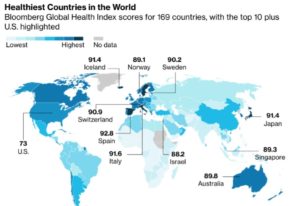- Bloomberg recently released its annual index of the world’s healthiest countries, which it compiles by grading countries on factors such as smoking rates, access to clean water, obesity, sanitation and more.
- Spain topped the list this year — thanks in part to the nation’s healthy Mediterranean diet, the report suggested.
Here are the world’s top 5 healthiest countries - The U.S. ranked 35th, likely due in part to poor American eating habits.
Spain – with its Mediterranean diet and high life expectancy – is the world’s healthiest country, according to Bloomberg 2019 Healthiest Country Index (https://www.bloomberg.com/news/articles/2019-03-01/a-billionaire-forged-in-freefire-the-fortnite-of-singapore).
The last gauge, published in 2017, ranked Spain in sixth. Bloomberg’s annual index measures variables such as obesity, smoking rates, alcohol use, childhood malnutrition, sanitation and clean water. This year, five European nations scored spots on the top ten list. Meanwhile, the U.S. ranked 35th.
What makes Spain the healthiest country? One likely factor is its universal healthcare system.
“Primary care is essentially provided by public providers, specialized family doctors and staff nurses, who provide preventive services to children, women and elderly patients, and acute and chronic care,” according to the European Observatory on Health Systems and Policies 2018 review (http://www.euro.who.int/__data/assets/pdf_file/0008/378620/hit-spain-eng.pdf? ua=1) of Spain.
Another reason might be the Mediterranean diet, which includes olive oil, vegetables, nuts and fruits; moderate amounts of fish, wine and dairy products; and low consumption of non-fish meat. Sticking to this heart-healthy diet is associated with a longer lifespan and fewer major cardiovascular events (http://www.predimed.es/uploads/8/0/5/1/8051451/nejmoa1800389_olf.pdf). But, to be sure, some say it’s not just about the ingredients.
“The Mediterranean diet is much more than a healthy gastronomic recommendation,” says Spain’s official tourism website (https://www.spain.info/en_US/reportajes/el_sabor_mas_saludable_dieta_mediterranea.html#) “It is a way of life that involves preparing food traditionally and enjoying it with friends and family, in a calm and relaxed environment. This is why it has been awarded the UNESCO Intangible Cultural Heritage designation.”
In terms of life expectancy at birth, Spain ranks first in the European Union and third globally, behind Japan and Switzerland. By 2040, Spain’s life expectancy is projected to hit nearly 86 years, the highest in the world, according (http://www.healthdata.org/news-release/how-healthy-will-we-be-2040) to the University of Washington’s Institute for Health Metrics and Evaluation.
Source: Bloomberg (https://www.bloomberg.com/news/articles/2019-03-01/abillionaire-forged-in-free-fire-the-fortnite-of-singapore)
The next nations on the list are Iceland, Japan, Switzerland and Italy, which this year dropped from the top spot. Still, it’s worth noting that it’s hard to accurately gauge the healthiness of nations and the results of various indexes vary when they use different methodologies. The Legatum Prosperity Index 2018, for instance, found that Spain ranked 22 on its list of the world’s healthiest countries (Singapore was number one).
But interestingly, one thing those two indexes did agree on was that the U.S. isn’t a particularly healthy country – both ranked it 35th.
Why is the U.S. lagging behind?
One clear factor is diet. Nearly half of Americans suffer from some kind of chronic disease as a result of poor diet, including heart disease and type 2, according to the 2015–2020 Dietary Guidelines for Americans report (https://health.gov/dietaryguidelines/2015/guidelines/introduction/nutrition-andhealth-are-closely-related/). What’s more, an astounding two-thirds of American adults and almost one-third of children are overweight or obese. These rates are tied in part to the prevalence of processed and otherwise cheap and unhealthy foods in the U.S.
Unlike the Spaniards, however, there’s really no generally observed American diet, though we do tend to eat more fast food and fewer vegetables (unless you count potatoes and tomatoes (https://www.npr.org/sections/thesalt/2015/09/19/441494432/the-u-s-doesnt-haveenough-of-the-vegetables-were-supposed-to-eat)) than other developed countries – though our taste for fast food has in recent decades spread to other nations, particularly in Asia. But perhaps the worst trait of Americans’ eating habits is eating enormous portions – something you can actually see in the increased size of dinnerware since the 1960s (https://www.chicagotribune.com/lifestyles/health/schealth-1102-portions-20111102-story.html).
“It’s a long-standing principle in America that we’re a land of plenty and we value bigness,” sociologist Barry Glassner, author of “The Gospel of Food: Why We Should Stop Worrying and Enjoy What We Eat”, told the Chicago Tribune (https://www.chicagotribune.com/lifestyles/health/sc-health-1102-portions-20111102story.html).
“That’s coupled with a very common American interpretation of what counts as value. Getting more for less is something that we tend to think is a good thing.”
In addition to diet, Americans have in recent years been dying more frequently of suicide (https://www.cbsnews.com/news/cdc-us-life-expectancy-declining-duelargely-to-drug-overdose-and-suicides/) and drug overdoses (https://www.cbsnews.com/news/americans-more-likely-to-die-from-accidentalopioid-overdose-than-in-a-car-accident/). The U.S. opioid epidemic is also steadily getting worse, with the nonprofit National Safety Council (https://injuryfacts.nsc.org/all-injuries/preventable-death-overview/odds-of-dying/) reporting in January that more Americans now die from opioids than car accidents.


